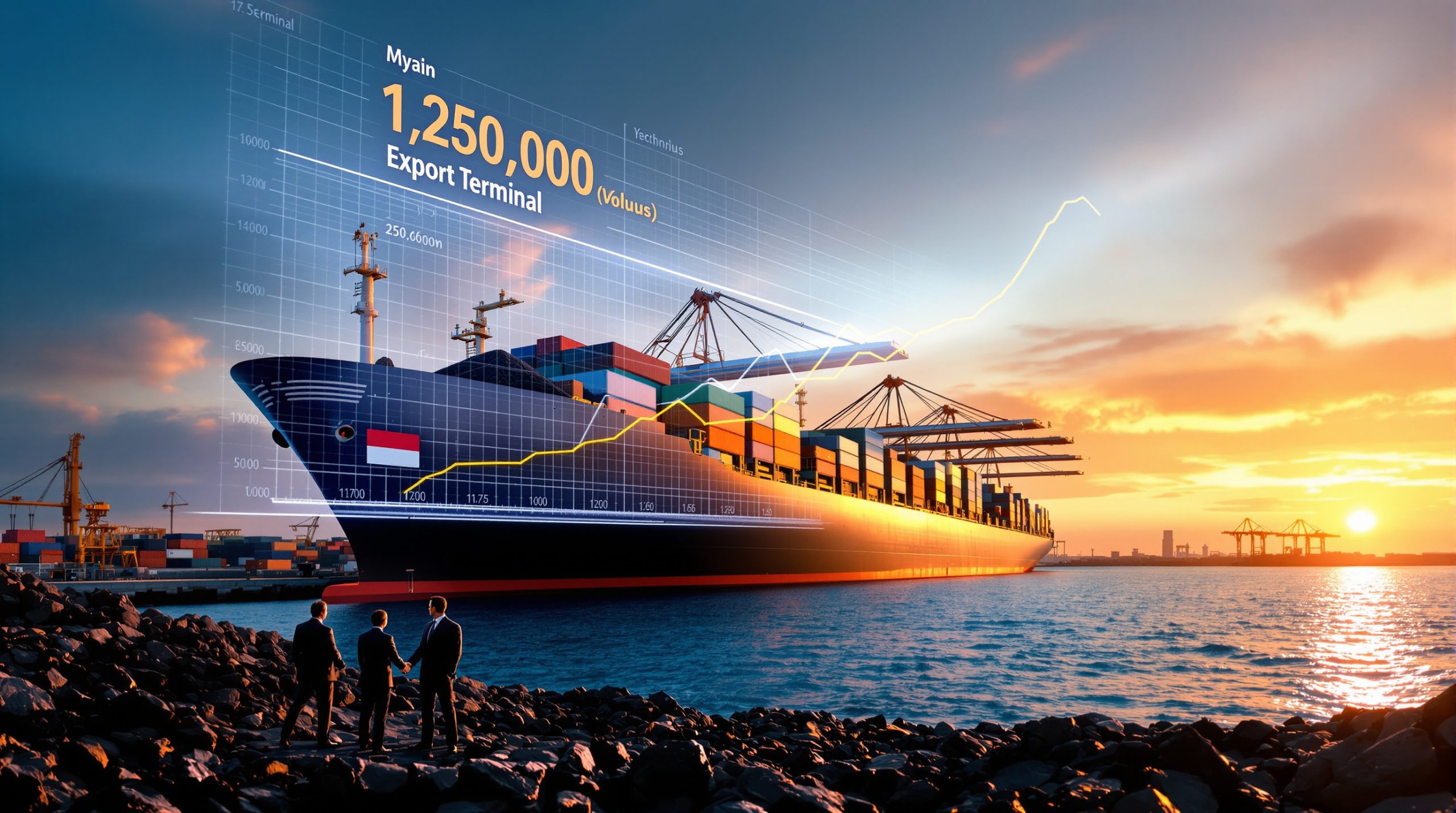Pilbara Ports Climate Action Plan: Leading Maritime Decarbonization
Australia's largest bulk export port authority has taken a significant step toward sustainable maritime operations with the release of a comprehensive new climate strategy. The Pilbara Ports Authority's inaugural Climate Action Plan (2025-2030) establishes a framework for reducing carbon emissions while maintaining operational excellence across Western Australia's resource-rich Pilbara region.
As the gateway for 81% of Australia's iron ore trade and 43% of global iron ore shipments, Pilbara Ports plays a crucial role in the nation's resource economy. The five-year strategy outlines practical initiatives across three key areas: opportunity development, climate resilience, and emissions reduction.
Why Has Pilbara Ports Developed This Climate Strategy?
The development of this comprehensive climate plan responds to growing global pressure for maritime decarbonization while safeguarding the port authority's impressive operational performance. With 775.7 million tonnes of cargo valued at approximately $153 billion passing through its facilities in FY25, Pilbara Ports faces dual challenges of maintaining efficient trade flows while addressing environmental impacts.
The strategy aligns with international maritime decarbonization initiatives, positioning the port authority as a leader in sustainable shipping infrastructure across the Asia-Pacific region. By proactively addressing climate risks, the authority aims to future-proof its operations against physical climate impacts while supporting Australia's broader transition to a low-carbon economy.
Recent achievements underscore the port's significance – the authority has recorded six consecutive years of record-breaking throughput, culminating in the 775.7 million tonnes handled in FY25. This performance demonstrates that climate action and operational excellence can advance together rather than compete.
The Three Key Pillars of the Climate Action Plan
Climate Change Opportunity
The first pillar identifies strategic growth opportunities in maritime decarbonization, positioning Pilbara Ports at the forefront of the transition to cleaner shipping. Key initiatives include:
-
Clean Fuel Bunkering Hub Development: Creating dedicated infrastructure for next-generation marine fuels to service vessels transitioning from conventional fuels
-
Ammonia Bunkering Trials: Establishing protocols and safety procedures for handling zero-carbon marine fuels like ammonia, which is expected to become a significant alternative fuel
-
Green Corridor Development: Establishing low-carbon shipping routes with international partner ports to create end-to-end decarbonized maritime supply chains
-
International Port Partnerships: Formalizing cooperation through memorandums of understanding with global ports to align decarbonization efforts
These initiatives position the Pilbara as a potential leader in maritime fuel transition, creating new economic opportunities while supporting global shipping's move away from conventional fuels.
Climate Change Resilience
The second pillar focuses on protecting critical infrastructure and operations from climate-related impacts, particularly important given the Pilbara region's exposure to extreme weather events. Key initiatives include:
-
Climate Risk Scenario Analysis: Conducting comprehensive modeling of potential impacts across different warming scenarios to identify vulnerabilities
-
Coastal Hazard Management: Developing adaptation plans specifically for Port Hedland and Dampier to address sea-level rise, storm surge, and cyclone impacts
-
Risk Framework Integration: Embedding climate considerations into operational risk assessments to ensure climate factors inform all decision-making
-
Treasury Reporting Protocols: Establishing standardized climate risk reporting to government stakeholders, enhancing transparency and accountability
These measures aim to safeguard billions of dollars in national export infrastructure while ensuring operational continuity despite increasing climate variability.
Emissions Reduction
The third pillar outlines concrete steps to reduce the carbon footprint of port operations and support users' decarbonization efforts:
-
Net-Zero Transition Planning: Creating a detailed roadmap for achieving operational carbon neutrality across all port activities
-
Scope 3 Emissions Analysis: Measuring and addressing supply chain emissions through collaboration with port users and shipping companies
-
Renewable Energy Integration: Conducting feasibility studies for implementing renewable energy integration at Port Hedland, Australia's largest bulk export port
-
Collaborative Emissions Forecasting: Working with port users to model future emissions scenarios and identify reduction opportunities
These initiatives demonstrate a comprehensive approach to emissions management, addressing both direct operational impacts and the broader supply chain.
How This Plan Supports Pilbara Ports' Operational Success
Pilbara Ports has achieved remarkable operational performance, with six consecutive years of record-breaking throughput culminating in 775.7 million tonnes of cargo handled in FY25. The Climate Action Plan aims to maintain this excellence while addressing environmental challenges through:
| Port | FY25 Throughput | Year-on-Year Change |
|---|---|---|
| Port Hedland | 577.7 Mt | +1% |
| All Pilbara Ports | 775.7 Mt | Record high |
| Iron Ore Exports | 730.8 Mt | +3% from FY24 |
The plan recognizes that climate action and operational efficiency are complementary rather than competing priorities. By investing in climate resilience and emissions reduction, Pilbara Ports aims to protect its infrastructure against physical climate risks while positioning itself as a preferred gateway for environmentally conscious shipping companies.
This balanced approach ensures that decarbonization efforts support rather than hinder the authority's core mission of facilitating efficient trade flows.
Strategic Significance for Australia's Resources Sector
Economic Importance to National Exports
As the primary export channel for Australia's iron ore industry, Pilbara Ports' climate initiatives will influence the environmental footprint of a significant portion of national resource exports. The authority's facilities handle:
-
81% of Australia's iron ore exports
-
43% of global iron ore trade
-
Approximately $153 billion in annual trade value
These figures highlight the strategic importance of the Pilbara ports to both the national economy and global supply chains. Climate actions taken here have outsized impacts on Australia's export emissions profile.
Leadership in Maritime Decarbonization
The plan positions Pilbara Ports at the forefront of maritime sustainability in several ways:
-
First-Mover Advantage: Early adoption of clean marine fuels infrastructure positions the ports to capture market share in the emerging green shipping economy
-
Regional Leadership: Setting standards for port decarbonization in the Asia-Pacific creates reputational advantages and potential policy influence
-
Supply Chain Integration: Collaborating with miners and shipping companies on emissions reduction creates end-to-end sustainability solutions
-
Climate Resilience Planning: Protecting critical national infrastructure against climate impacts ensures long-term viability of export routes
By taking this leadership position, Pilbara Ports not only addresses its own environmental impacts but also influences the broader maritime and resources sectors toward greater sustainability.
The Clean Fuel Bunkering Hub: Transforming Maritime Shipping
A centerpiece of the Climate Action Plan is the development of a Pilbara Clean Fuel Bunkering Hub, which represents a significant shift in maritime fuel infrastructure. This initiative will:
-
Provide specialized infrastructure for vessels to refuel with low and zero-carbon alternatives such as hydrogen, ammonia, and biofuels
-
Support the transition from conventional marine fuels to cleaner alternatives, reducing shipping emissions
-
Establish the Pilbara as a strategic node in emerging green shipping corridors between Australia and key trading partners
-
Create new economic opportunities in clean fuel production, storage, and distribution
The bunkering hub initiative builds on Western Australia's broader energy transition strategies and leverages the region's renewable energy potential to support green hydrogen and ammonia production for shipping applications.
This development represents a significant opportunity for the Pilbara to diversify its economic base while maintaining its central role in global maritime trade.
Renewable Energy Integration in Port Operations
The Climate Action Plan includes a dedicated feasibility study for renewable energy integration at Port Hedland, Australia's largest bulk export port. This initiative aims to:
-
Reduce operational emissions from port facilities through clean electricity generation
-
Decrease reliance on fossil fuel-powered electricity, improving energy security
-
Support the electrification of port equipment and vehicles, reducing local air pollution
-
Potentially provide shore power for visiting vessels, allowing ships to turn off diesel generators while in port
By transitioning to renewable energy sources, Pilbara Ports can significantly reduce its Scope 1 and 2 emissions while demonstrating the viability of clean energy in industrial maritime applications. The Pilbara's abundant solar resources make it ideally positioned for this transition.
Climate Resilience: Protecting Critical Infrastructure
The plan acknowledges the Pilbara region's vulnerability to climate-related hazards including cyclones, storm surge, and sea-level rise. To address these risks, Pilbara Ports will:
-
Conduct comprehensive climate risk assessments for all facilities to identify vulnerabilities
-
Develop port-specific coastal hazard management plans for Dampier and Port Hedland to guide adaptation investments
-
Integrate climate considerations into infrastructure planning and design to ensure long-term resilience
-
Establish monitoring systems for emerging climate threats to enable early response
These measures aim to protect billions of dollars in national export infrastructure while ensuring continuity of operations despite increasing climate variability. The focus on both mitigation and adaptation demonstrates a holistic approach to climate management.
Implications for the Future of Resource Shipping
Pilbara Ports' Climate Action Plan signals a significant shift in how bulk commodity exports will be managed in a carbon-constrained future. Key implications include:
-
Green Premium Potential: Environmentally optimized export routes may command market advantages as customers increasingly value low-carbon supply chains
-
Infrastructure Transformation: Gradual reconfiguration of port facilities to support clean fuels and renewable energy will create new operational models
-
Collaborative Decarbonization: Increased coordination between miners, ports, and shipping companies will be necessary to achieve meaningful emissions reductions
-
Resilience Investment: Growing capital allocation toward climate-proofing critical export infrastructure will become standard practice
The plan represents an important acknowledgment that even traditional bulk commodity exports must adapt to climate imperatives while maintaining operational efficiency. This balancing act will define resource logistics in the coming decades.
Leadership Perspective on the Climate Action Plan
Pilbara Ports Chief Executive Officer Samuel McSkimming has emphasized the strategic importance of the Climate Action Plan, noting:
"As one of Australia's leading facilitators of iron ore trade, we play a vital role in driving the global transition to net zero by 2050. Our ports are critical to global trade, and this Pilbara Ports new Climate Action Plan ensures we remain a strong, resilient gateway for exports while ensuring we meet our climate action goals."
This statement underscores the dual focus on maintaining operational excellence while embracing climate leadership—a balance that will be critical for resource export infrastructure in the coming decades.
McSkimming further highlighted the plan's focus on "tangible steps to future-proof port operations by supporting decarbonisation initiatives through the ports," demonstrating the practical, action-oriented nature of the strategy.
Frequently Asked Questions About Pilbara Ports' Climate Action
How will the Climate Action Plan affect port throughput capacity?
The plan is designed to complement rather than constrain operational capacity, with climate initiatives integrated into existing expansion and efficiency programs. The goal is to maintain or improve throughput while reducing environmental impacts.
Will shipping costs increase due to these climate initiatives?
While some initiatives may require capital investment, many climate measures also deliver operational efficiencies that can offset costs over time. Additionally, early adoption may reduce compliance costs as regulatory requirements increase.
How will Pilbara Ports measure the success of its Climate Action Plan?
The authority will likely establish key performance indicators around emissions reduction, climate risk mitigation, and clean energy adoption to track progress. Regular reporting on these metrics will provide transparency to stakeholders.
Will these initiatives affect iron ore competitiveness in global markets?
By getting ahead of inevitable maritime decarbonization requirements, these measures may actually enhance the competitiveness of Australian iron ore by reducing its carbon footprint. As carbon becomes increasingly priced into global markets, this could become a competitive advantage.
How does this plan compare to climate initiatives at other major ports?
Pilbara Ports joins leading global ports like Rotterdam, Singapore, and Los Angeles in developing comprehensive climate strategies, though with a unique focus on bulk commodity exports. The emphasis on both operational excellence and environmental performance aligns with best practices globally.
Further Resources
For those interested in learning more about maritime decarbonization initiatives, additional information is available through the Pilbara Ports Authority website, which covers ongoing developments in port infrastructure and sustainability in the resources sector.
The Pilbara Ports new Climate Action Plan represents an important milestone in the decarbonisation trends 2025 of Australia's resources supply chain, balancing environmental responsibility with economic performance in one of the nation's most strategically important export gateways. Furthermore, the implementation of sustainable mining practices and mining electrification insights will be crucial for the success of this ambitious plan.
Interested in Discovering the Next Major Mining Opportunity?
Discovery Alert's proprietary Discovery IQ model provides real-time notifications on significant ASX mineral discoveries, helping investors capitalise on potential high-growth opportunities before the broader market. Visit our discoveries page to understand how major mineral finds can generate substantial returns for early investors.




